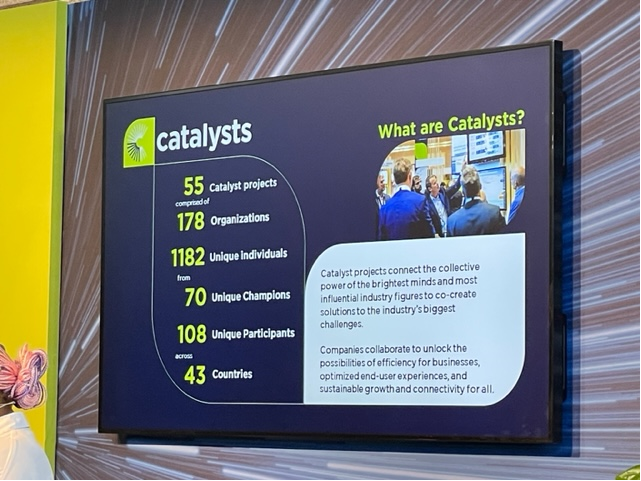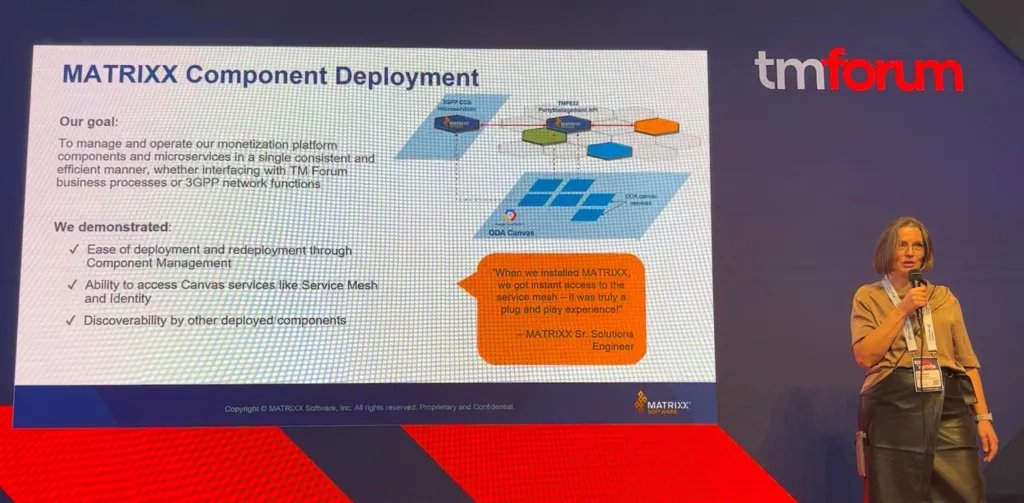- Product
Product
MATRIXX PlatformCommercial Benefits
Rapid Commercial InnovationCustomer-Centric SolutionsUnified, Real-Time RevenueDynamic Operational FlexibilityTechnical Benefits
High Performance Core5G CHF | CCS ArchitectureAPI-FirstClick-Not-CodeTrue Cloud NativeUnified Commerce- Opportunities
Market Segments
ConsumersSmall and Medium EnterpriseLarge EnterpriseGovernment NetworksPrivate Cellular NetworksWholesale- Customers
Overview
Success HighlightsBusiness Case Studies
DISH - Standalone 5GLiberty Latin America - Group TransformationOrange Romania - Rapid Brand InnovationTelefónica - Converged ChargingTPG Telecom - Multi-Brand StrategySuccess Stories
iD MobileOne NZ - ConsumerOne NZ - EnterpriseOrange PolandSwisscomTata CommunicationsTelstra- Partners
Be A Partner
Partner Program OverviewPartner Resources
Education & TrainingStrategic Initiatives
Blue Planet | Dynamic Monetization of 5GCelfocus | Digital BillingGoogle | Confidential ComputeIBM | Telco Cloud PartnershipMicrosoft and Blue Planet | Monetize 5G ExperiencesRed Hat OpenShift | Hybrid CloudSalesforce | Digital ExperiencesTallence | Charging TransformationPartner Case Studies
AWS CI/CD Pipeline- Resources
Events & Webinars
Webinars On-Demand- Company
Key Takeaways from Digital Transformation World 2023
Monica RicciDigital Transformation World (DTW) is the premiere event for telco stakeholders to examine their current state, explore where their digital transformation journey is heading, and, above all else, understand how to collaborate to make progress. After another successful event in Copenhagen, the MATRIXX Software team wanted to share thoughts and key takeaways.
The three-day event facilitates knowledge sharing for the collective benefit of the industry by players from across the value chain, from the most prominent global operators to startups, from significant software and services firms to niche, focused solution providers. With this worldwide draw and executive focus, the MATRIXX team hosted a valuable executive dinner where nine telco CIOs exchanged thoughts on their digital transformation journeys.
Catalyst Projects Drive Telco Efficiency, Customer Experience and Growth
Catalyst projects remain central to DTW activities and showcase collaboration to co-create solutions that demonstrate how to drive telco processes efficiency, enhance customer experiences and, above all else, stimulate growth in the sector. The numbers indicate that the industry has been convinced: there were 38% more Catalyst projects on display this year, with a 19% increase in the number of participating companies co-creating solutions and a staggering 63% increase in team members designing and developing proofs of concept, writing business cases and delivering the story of how value is created. On the qualitative front, our team observed an increased focus on delivering business outcomes above and beyond showcasing technology and interoperability.

MATRIXX contributed to three projects this year, each one highlighting a dimension of the 3 Cs of digital business architecture: convergence, composability and cloud native. We continued our work with Telefónica and NTT Data on the B2B2X smart spaces project, demonstrating how CSPs can collaborate to automatically provide enhanced connectivity and services to all stakeholders in a sports arena, from audience members to vendors to service providers and network operators alike. Along with NTT Docomo, Salesforce, and HP Enterprise, the team evolved the solution to demonstrate the creation of multi-layered convergent offers combining telco and non-telco products, with MATRIXX digital monetization charging and sharing revenue with all parties in the value chain in real-time.
Our team joined another Catalyst this year led by Deutsche Telekom and IBM, with Telecom Egypt and Airbus, that focused on automated service assurance across a federated environment of network operators, showcasing how a CSP can monitor service quality, intelligently and proactively make adjustments to maintain SLAs for a global enterprise customer and compensate when they aren’t met. Integrated with components from SAP, MYCOM OSI and Flytxt, MATRIXX contributed the real-time monetization component to adjust the enterprise’s balances when an SLA was missed or when products were adjusted to reflect a change in usage.
ODA Canvas Collaboration with Google, Orange and Ericsson
We also partnered with Google, Orange and Ericsson to demonstrate deploying cloud native components on an Open Digital Architecture (ODA) Canvas and leveraging common capabilities. Orange demonstrated creating their ODA Canvas environment using Google Cloud Platform’s infrastructure, while MATRIXX and other vendors deployed their components successfully in the Google ODA Canvas environment. The deployed components could instantly utilize common Canvas services like service mesh and identity and were automatically discoverable by and interoperable with other components through Open APIs. Throughout DTW, there was increased interest in ODA, with more CSPs achieving the “Running on ODA” badge and several software vendors recognized with the “Ready for ODA” stamp. The elevation of ODA reflects an acceptance that software component deployment and lifecycle management operations in multi-vendor solutions are critical elements to achieving the agility needed by a digital enterprise.

Elisabeth Andersson, from MATRIXX CTO office, presents our ODA deployment.
Unveiling AI’s Prominence in Telco Transformation
But we can’t forget about AI. It was everywhere you turned. At least one Innovation Arena presenter described how their team incorporated GenAI as the “flavor of the month” alongside using and contributing to TM Forum assets. The “flavor of the month” designation felt well-deserved, given the speed with which most of the Catalyst projects and the show’s exhibitors brought AI to the front and center. Our assessment is that it’s early days for AI in telco since most use cases that were showcased presented enhancements to business and operational challenges that are common across all sectors and are not telco-specific. You could see automated code generation, intelligent knowledge management, device discovery and management and analysis of published rate plan data. But the prevalence of AI shows how rapidly it is becoming an essential part of the telco industry. We expect operators and vendors together to showcase meaningful progress in 2024, using AI in ways that will incorporate intelligence that lives only in networks and in CSP operational data and using that to impact revenue in measurable ways.
The Journey in Digital Monetization Continues
The customers, prospects, partners, analysts and media we met in Copenhagen validated MATRIXX’s focus on digital monetization. The industry recognizes that, in the midst of digital transformation, yesterday’s BSS must evolve into digital business architectures with all the benefits of convergence, composability and cloud native. These benefits extend from the telco bottom line to the top line, with adaptable and configurable infrastructure accelerating innovation and new value models. The monetization strategies we heard about focused on emerging technologies like 5G — yes, it’s still emerging — edge computing and network APIs. And despite the sluggish economy giving telcos a relatively tough time this year, we were encouraged by their focus on transformation for growth, not just for efficiency and cost-cutting. We are excited to continue this journey and demonstrate progress with our partners and customers in 2024!
Pin It on Pinterest
- Opportunities
